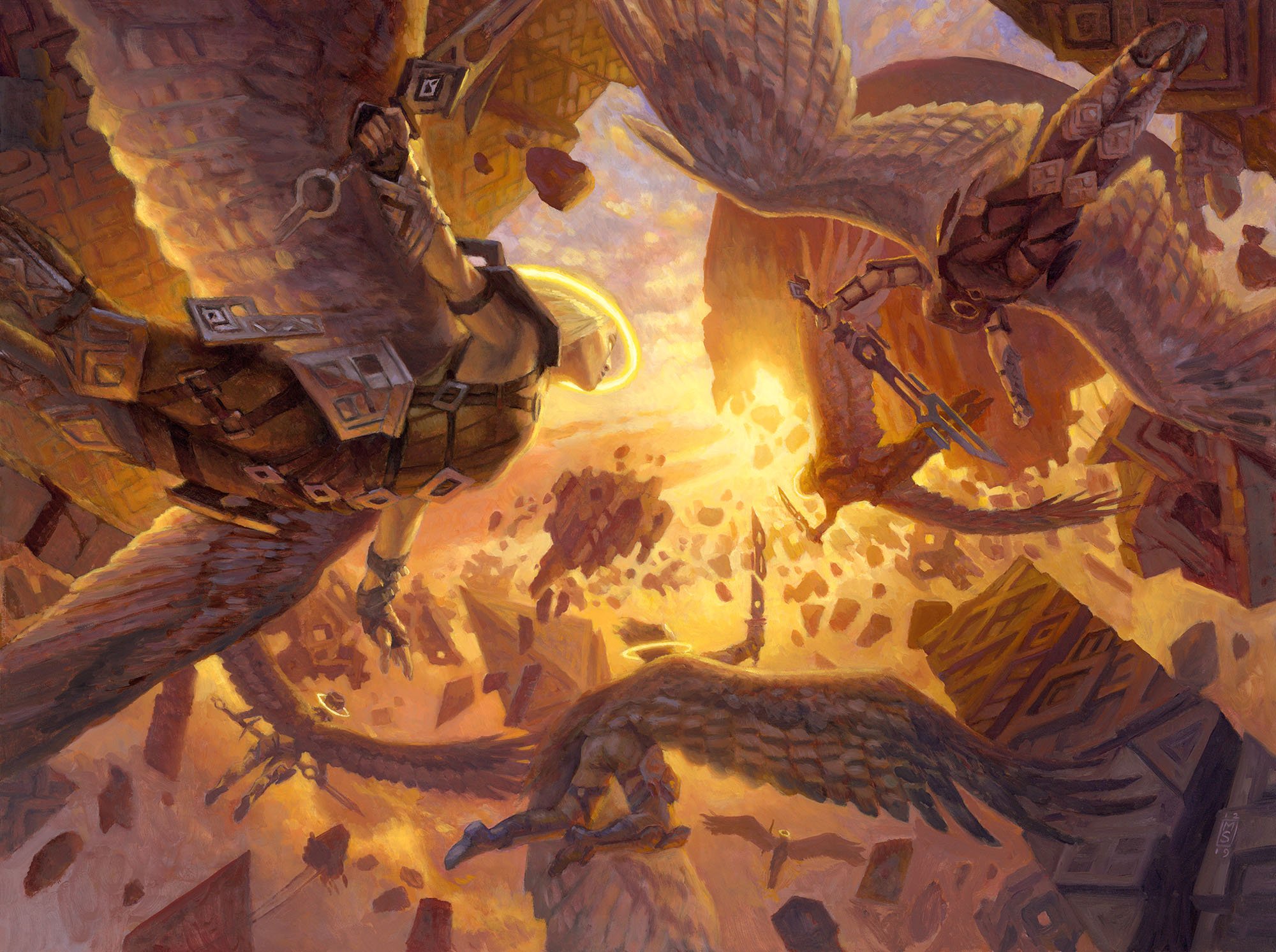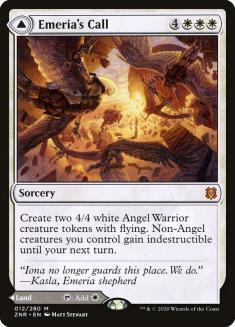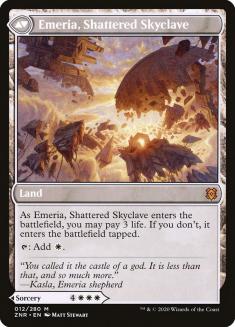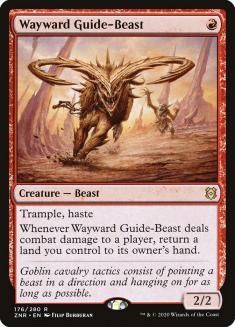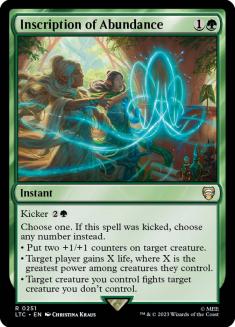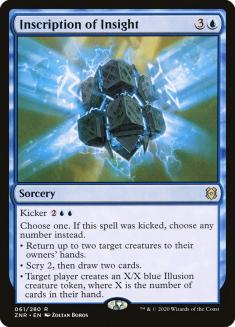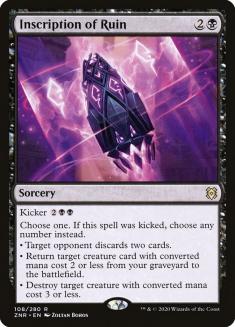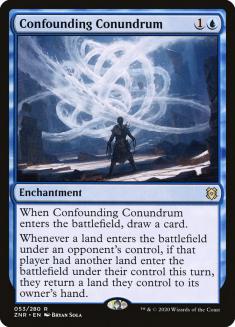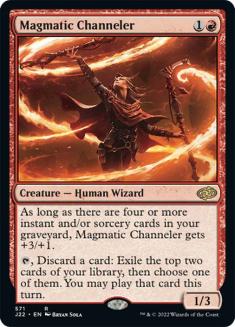Welcome to another edition of Fact or Fiction! Today, Sam Black, Bryan Gottlieb, and Ryan Overturf are here to give their takes on five statements about Zendikar Rising. Don’t forget to vote for the winner at the end!
1. Emeria’s Call will be the best of the five mythic modal double-faced cards in Zendikar Rising Standard.
Sam Black: Fact. Emeria’s Call is the most flexible of the cycle in that it doesn’t ask anything in deckbuilding, unlike Agadeem’s Awakening and Turntimber Symbiosis, and it generally gives you a big effect on any battlefield, whereas Shatterskull Smashing and Sea Gate Restoration require more specific contexts in-game. Given that what I want out of these cards is the ability to turn a land into a high impact spell any time I already have enough mana, I think Emeria’s Call will accomplish that goal most consistently with the fewest deckbuilding considerations.
For now, I suspect that most decks that want at least half of their lands to tap for white mana should play four Emeria’s Calls by default, which I wouldn’t say for the others.
Bryan Gottlieb: Fiction. Emeria’s Call sits right in the middle of the pack. Sea Gate Restoration is a near-unplayable seven mana win-more (sorry, Shaheen). Shatterskull Smashing seems fine but unexciting and will occupy a niche role in midrange red decks.
Emeria’s Call occupies the unique space of finisher and land, and its inclusion will enable utter indifference to winning the game when building control decks. I love when control decks get to win games almost by accident, especially when the upside of building your deck in such a fashion is a 30-land manabase that assures you never have to play a game off-curve. Even if its effect doesn’t blow me away, its utility does.
Slightly better than Emeria’s Call, Turntimber Symbiosis has a baseline application of being lands 24-27 in green aggressive decks that would appreciate the consistency but fear the flood. If midrange green is creature-dense enough, this will be pulling haymakers out of decks there as well. And if there happens to be a broken creature printed anytime soon, you can bet Turntimber Symbiosis will be attempting to cheat it onto the battlefield. This is even destined to see some Modern play alongside Primeval Titan.
The card that will really take over Standard is Agadeem’s Awakening. Every black deck I build finds itself happy to include multiple copies of this card. It’s completely possible that with no land stapled on the back I’d be going out of my way to make this work. With the land, it’s format-defining.
Creatures (19)
Lands (24)
Spells (17)
- 2 Soul-Guide Lantern
- 3 Agonizing Remorse
- 1 Call of the Death-Dweller
- 4 Village Rites
- 3 Bloodchief's Thirst
- 1 Inscription of Ruin
- 3 Agadeem's Awakening
Sideboard

Ryan Overturf: Fact. Emeria’s Call has a lot in common with Broodmate Dragon, though the two cards have a few differences. Broodmate Dragon was part of a dominant Standard deck once upon a time, and the other modal double-faced cards in this cycle aren’t evocative of anything on this level. Sea Gate Restoration and Shatterskull Smashing are both weak versions of their respective effects that have the land side of the card doing the heavy lifting. Turntimber Symbiosis is solid in a creature-heavy deck or one that has a few creatures that can win the game on their own, but decks like this in Standard tend to be in a lot of trouble by the time they can produce seven mana. Agadeem’s Awakening definitely can win the game on resolution in a lot of theoretical spots, and I would consider it the most serious competition here.
With Mayhem Devil and Priest of Forgotten Gods on the outs, the sorts of decks that would want to play Agadeem’s Awakening have some things to figure out in post-rotation Standard. There are still tools there, and if I was feeling more adventurous I might be bold and call it the best of the cycle. I’m going to go ahead and lean on making two 4/4 flyers being just a generically powerful thing to do with a card that takes a land slot in your deck and call it good though.
2. Wayward Guide-Beast is Constructed-playable and far better than people think.
Sam Black: Fact. Maybe fact-lite. I think it’s underrated, but not massively underrated. On Turn 1 you basically never want to attack with it, but that’s fine; Ghitu Lavarunner could never attack on Turn 1 either and it was good enough. The issue is that it rarely wants to attack on Turn 2 either, which is a serious strike against it, but I still don’t think it’s a deal-breaker. From Turn 3 on, it’s a great way to double spell in an aggressive deck.
In most contexts, I still wouldn’t be sold, but you have to consider that this actually nets you a mana any time it connects if you didn’t have a land to play, and it exists alongside landfall and a bunch of spells that you can play as lands that this lets you pick up when you want to cast them.
In that kind of context, I think this card has real potential.
Bryan Gottlieb: Factish. Here’s the problem with calling cards the “new X.” Wayward Guide-Beast isn’t supposed to be a Goblin Guide replacement. It’s supposed to be enabling landfall. In the absence of fetchlands, it’s clear the aggressive landfall creatures need an engine. You can plausibly put together some scenarios built around cards like Azusa, Lost but Seeking or Radha, Heart of Keld where you are happily returning lands to your hand for additional landfall triggers, all while unlocking spells that you previously played as lands.
I can’t go hard “fact” here, because based on what we’ve seen of the set thus far, these theoretical decks still strike me as underpowered when compared to everything else going in the format. But I haven’t played with or even built these archetypes yet, and writing off this card because it’s not Goblin Guide seems premature to me. I think this will end up brick-walled a lot and rarely achieve its maximum upside, but people have been treating it like a Wood Elemental. It’s not that offensive.
Ryan Overturf: Fiction. Evaluating new Magic cards is really hard. That’s going to be my excuse if this card ends up being good anyway. I just can’t force myself to go to bat for a one-drop that’s really bad on Turn 1, especially considering that a lot of Standard in the last couple of years has had to do with assembling some kind of value engine and making all of your land drops. Sure, Embercleave had its time in the sun, but before that the best red deck in Standard was based around Experimental Frenzy. Let me paint you a picture here. Actually, I’ll let Vincent Proce take care of the painting.
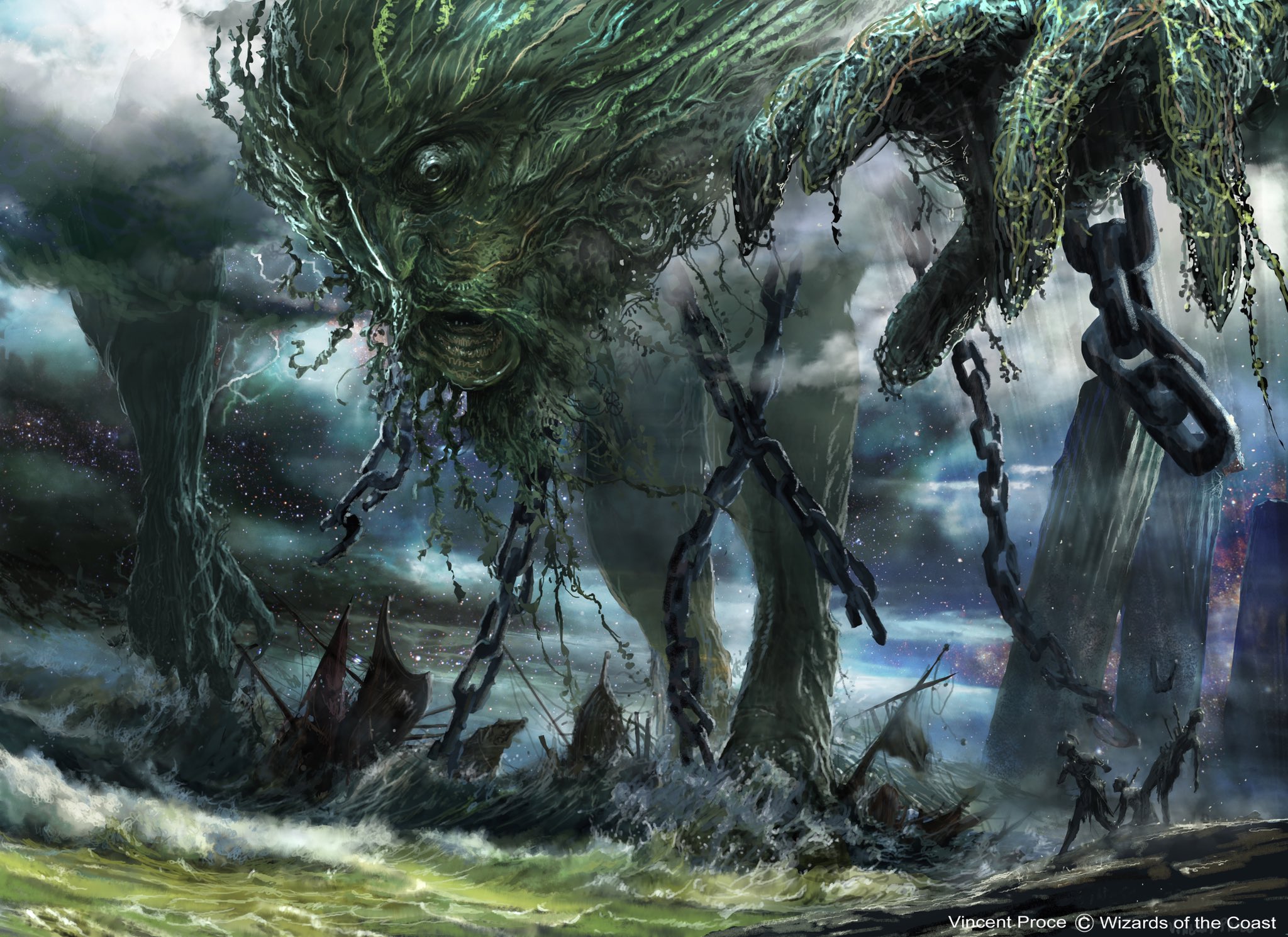
I’m sure Wayward Guide-Beast is one of those cards that’s supposed to excite people to think outside the box and isn’t intended to be a Constructed all-star. That doesn’t make me any less sad to look at it side by side next to Uro, Titan of Nature’s Wrath.
3. You’re excited about Magic’s newest cycle — the Inscriptions!
Sam Black: Fact. Low-key excited. I don’t think these are a very big deal, but I like a modal spell as much as the next player, and it’s hard not to appreciate kicker as a way of mitigating flood and letting people play and resolve big, swingy effects to keep games interesting.
From what I’ve seen, I think these cards come in at fringe Constructed rate. They’re solid versatile effects, but I think the base rate just isn’t quite at 2020 Magic power levels. Most likely, they’ll see minimal play, but they’re cool options and I’d be happy to see them in a Cube Draft in the future.
Bryan Gottlieb: Fact. I love options in Magic. Cryptic Command did (and continues to do) some offensive things to games, but it’s also responsible for a lot of incredible stories and crafty play. I would say the same thing about Sublime Epiphany. These Inscriptions are trying to set up similar moments, but by moving the versatility to sorcery speed, it’s getting away from some of the “damned if you do, damned if you don’t” nature of the aforementioned cards.
There’s also the inherent tension between expending these cards for efficiency and trying to hold out for their kicked modes. Kicker is such a good mechanic when used in this fashion. It helps prevent non-games, allows comebacks, and will create highlight-reel moments… what’s not to love?
Ryan Overturf: Fact. These cards are sweet. I’m sure Inscription of Insight is the sort of card that you’re never supposed to pass in Limited, and it does enough that I wouldn’t be surprised if it showed up in Standard. The prompt asked whether I was excited though, and I think modal spells that let you do all the things for a lot of mana are really exciting ways to get players to take eight-mana game actions.
Inscription of Ruin is a little less exciting on the “fully kicked” front, but it offers three things that are all solid for three mana and now and again I could see spending the full seven being great. Inscription of Abundance has the least exciting mode of the lot with the lifegain ability, but the other two modes are solid for Standard at instant speed, and five mana for the fully kicked card is a very reasonable cost.
4. Confounding Conundrum is a useful solution to Uro, Titan of Nature’s Wrath.
Sam Black: Fiction. Confounding Conundrum is likely worth the mana to cast it when you’re playing against Uro, but I don’t think it can be played maindeck because it’s such a bad use of mana against anyone who isn’t playing green. As a sideboard card, it seems extremely low-impact. It’s not like you can ignore a 6/6 that draws cards and gains life, so you haven’t meaningfully solved any of your problems.
Bryan Gottlieb: Fiction. The mana acceleration Uro provides is great. It’s nice to play my broken spells like Ugin, the Spirit Dragon on Turn 5 or 6. But Ugin is still pretty good on Turn 8, and if Uro were just a 6/6 for four mana that you couldn’t kill and drew an extra card every turn, it’d still be one of the best cards in Standard, if not the best.
Confounding Conundrum is a speed bump, not a solution. I won’t go as far as calling this worthless, but I think you should be gaining some additional benefit from this card if it’s making its way into your deck. I believe it could earn a spot alongside Yorion, Sky Nomad or based on enchantment synergies with cards like Setessan Champion or Calix, Destiny’s Hand. But if you’re putting this card into your sideboard as your de facto “Uro plan” you are almost certainly making a mistake. There are better tools for the job.
Ryan Overturf: Fiction. Confounding Conundrum is kind of neat to stop land-based ramp considering that it replaces itself, but if we’re talking about Uro that’s only one of the things that the card does. Some decks utilize Uro to power out Ugin, the Spirit Dragon, but a lot of Uro decks are just midrange strategies that are going to get by just fine drawing extra cards and taking advantage of a recurring 6/6.
Hate cards as a category are very often worse than players think they are and Confounding Conundrum doesn’t even address the parts of Uro that tend to matter the most. I imagine this card will matter a lot more in Commander than Standard.
5. Magmatic Channeler is the most powerful card previewed thus far from Zendikar Rising.
Sam Black: Fiction. It’s a nice two-drop, maybe even better than Priest of Forgotten Gods, but it’s really hard for me to get excited about a two-mana creature that I need to untap with. It’s not a full dealbreaker like it would be on a three-drop, and I don’t mean to imply that the fact that my opponent is up a mana if they kill this with Bloodchief’s Thirst means that I think this is unplayable. It might even become a Standard staple, but I don’t think it’s as powerful as Emeria’s Call or Agadeem’s Awakening, which offer something entirely new and increase the overall strength of a deck that includes them a lot more.
Bryan Gottlieb: Fiction. I think Magmatic Channeler is solid, but I’ve cooled off a bit on it over the last few days. There are multiple problems with this card that I was initially willing to hand-wave away but, now that I’ve built some decks, I’m starting to recognize as real. First, red midrange might be the archetype I’m least excited about headed into Zendikar Rising Standard. The card quality just seems a step behind, and I would extend this criticism to the Wizard tribe.
Second, four instants and/or sorceries is a number that reads small and plays big. Without cheating on these numbers via the classic offenders like Thought Scour or Gitaxian Probe, I think getting the bonus will be rarer than you anticipate, and even when you hit, how good is a 4/4 really? Magmatic Channeler still dies to most every removal spell in the format short of Shock. Heartless Act, Bloodchief’s Thirst, Glass Casket… they’re all still online.
Finally, I think this looting ability is being dramatically overrated. Magmatic Channeler demands that you build your deck in a way that will always present you with a card that you are happy to play immediately, otherwise you are tapping to discard a card. This means your mana curve must stay super-lean, and you must avoid reactive spells (especially countermagic). That’s a huge deckbuilding cost!
This isn’t to say I’m off Magmatic Channeler entirely. I’ve built several decks with it that I’m excited to try out. I just think it’s closer to a solid role-player than a multi-format all-star.
Ryan Overturf: Fiction. I think Magmatic Channeler is very cool. I’m really excited to try it in Pioneer in decks that gain value just by discarding cards. That said, if you go back to Modern, the card is a lot easier to kill before you can do anything with it, and if you look at the card in terms of Standard, then you don’t have many cards that are great to discard or fast ways to turn the card into a 4/4.
I think that most of the initial builds of Magmatic Channeler decks are going to involve players not understanding just how much support the card needs from both your own deck and the context of the format that you try to play it in. In Pioneer the card gains a lot from being a discard outlet and surviving Shock. In Standard the card is a 1/3 that might have upside. In Modern the card is a 1/3 that your opponent will pretty easily kill if they decide they care.
If we want to talk about this being some kind of “red Tarmogoyf,” then I would offer that Kargan Intimidator is just a better red beatdown card. In the broader conversation of what the most powerful card previewed from Zendikar Rising is, I would say that honor goes to Lotus Cobra or Emeria’s Call.
[crowdsignal poll=10606483]

